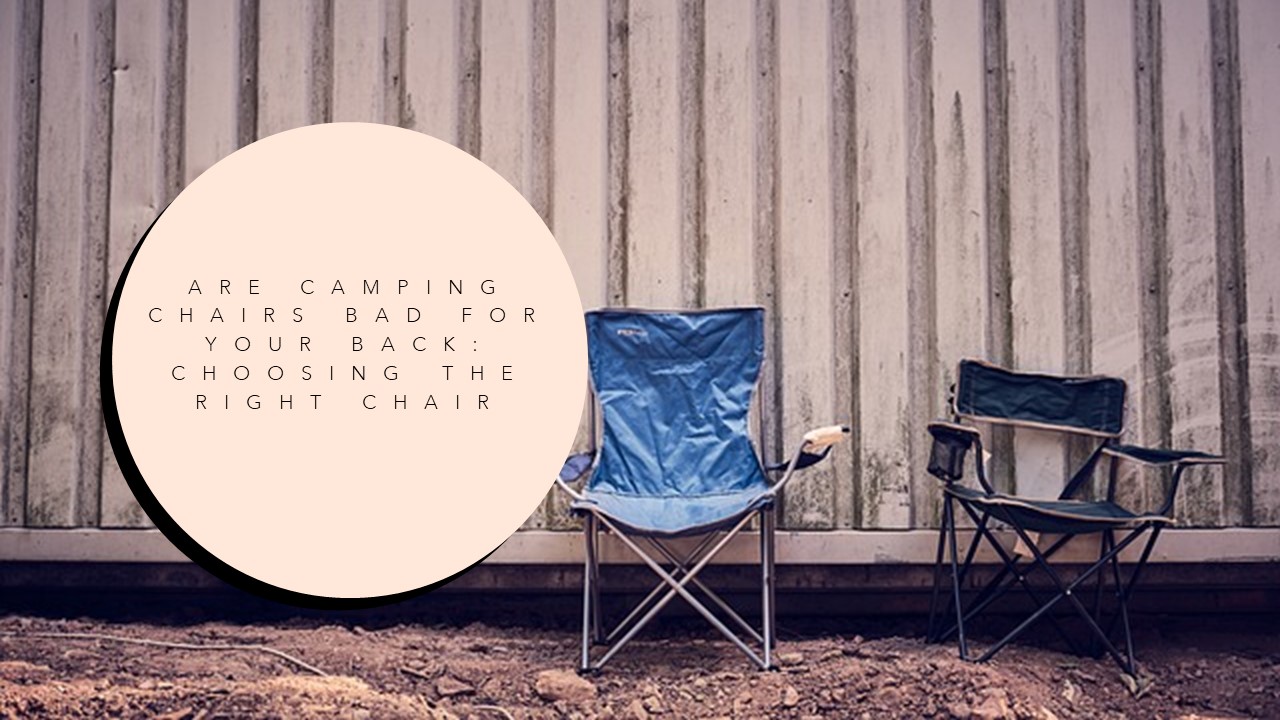Are all camping chairs bad for your back? Camping and outdoor activities are becoming increasingly popular among people looking to disconnect from their busy lives and enjoy the beauty of nature. However, spending time in the great outdoors often involves sitting for extended periods of time, whether it’s around a campfire, fishing on a riverbank, or enjoying a picnic in the park. Unfortunately, sitting for prolonged periods in the wrong chair can cause discomfort and even lead to long-term back pain.
In this article, I will explore the question, “Are camping chairs bad for your back?” and discuss the potential risks associated with using the wrong chair while camping. I will also provide tips for choosing the right camping chair and maintaining good posture while sitting to help prevent back pain.
The Anatomy of the Back
Before delving into the topic of whether camping chairs are bad for your back, it’s important to understand the anatomy of the back and how it functions. The back is made up of the spine, muscles, and ligaments, all of which work together to support the body and facilitate movement.
The spine is made up of a series of vertebrae that are stacked on top of each other, separated by intervertebral discs that act as shock absorbers. The spine is divided into three regions: the cervical spine (neck), thoracic spine (upper back), and lumbar spine (lower back).
The muscles and ligaments in the back play an important role in supporting the spine and facilitating movement. The muscles of the back are divided into two main groups: the superficial muscles that are responsible for movement and the deep muscles which are responsible for stability. The ligaments connect the bones of the spine and provide stability to the joints.
Maintaining proper spinal alignment is essential for maintaining good back health. Poor posture and incorrect positioning of the spine can cause strain on the muscles and ligaments in the back, leading to discomfort and pain. In the next section, I will explore the potential risks associated with using the wrong camping chair.
The Risks of Using the Wrong Chair
Camping chairs come in various designs, and not all of them provide adequate support for the back. Using the wrong chair while camping can lead to discomfort and even long-term back pain. Here are some potential risks associated with using the wrong camping chair:
- Poor spinal alignment. Many camping chairs are designed with a low backrest or no backrest at all, which can cause the spine to curve unnaturally, leading to poor spinal alignment. Poor spinal alignment puts pressure on the muscles and ligaments in the back, causing discomfort and pain.
- Strain on the neck and shoulders. Camping chairs that do not provide adequate support for the back can also cause strain on the neck and shoulders as the body compensates for the lack of support.
- Lack of circulation. Sitting in a camping chair for prolonged periods can cause a lack of circulation in the legs, leading to discomfort, numbness, and even blood clots.
- Long-term effects. Using the wrong camping chair for extended periods can cause long-term effects, such as chronic back pain, spinal misalignment, and even herniated discs.
It’s important to choose a camping chair that provides adequate support for the back to minimize the risk of these potential issues.
How to Choose the Right Camping Chair
Choosing the right camping chair can help prevent back pain and discomfort while enjoying the outdoors. Here are some factors to consider when selecting a camping chair:
- Support: Look for a camping chair that provides proper support for the back, including a high backrest and lumbar support. The chair should also be sturdy enough to support your weight.
- Comfort: Choose a chair that is comfortable to sit in for extended periods. Look for chairs with padded seats and backrests, as well as armrests and a footrest if desired.
- Size: Consider the size and weight of the chair. Choose a chair that is easy to transport and store, but also large enough to comfortably support your body.
- Durability: Look for a camping chair that is made of durable materials that can withstand outdoor elements such as sun, rain, and wind.
- Test the chair: Before buying a camping chair, sit in it and test it out. Make sure it provides adequate support and is comfortable to sit in for extended periods.
- Price: Finally, consider your budget when selecting a camping chair. There are chairs available at a range of price points, so choose one that meets your needs and fits within your budget.
By considering these factors, you can choose a camping chair that supports good back health and provides comfort while enjoying the great outdoors.
Tips for Maintaining Good Posture While Camping
Maintaining a good posture while sitting in a camping chair can help prevent back pain and discomfort. Here are some tips for maintaining good posture while camping:
- Sit with your back straight. Sit with your back straight and your shoulders relaxed. Avoid slouching or leaning forward, as this can put a strain on your back and neck.
- Use a chair with lumbar support. Choose a camping chair with lumbar support or use a lumbar roll to support the natural curve of your lower back.
- Keep your feet flat on the ground. Keep your feet flat on the ground, hip-width apart. This helps maintain proper alignment of your spine.
- Take breaks and stretch. Take frequent breaks to stand up, stretch, and move around. This helps prevent stiffness and promotes good circulation.
- Use a footrest. If your camping chair does not have a footrest, use a small stool or a pile of blankets to prop up your feet. This helps reduce pressure on your lower back and promotes good circulation.
- Avoid crossing your legs. Crossing your legs can cause an imbalance in your hips and pelvis, leading to strain on your back. Keep your feet flat on the ground instead.
Remember to choose a chair that provides adequate support for your back and test it out before buying to ensure it is comfortable and meets your needs.
Conclusion
In conclusion, camping chairs can be bad for your back if they do not provide adequate support and comfort. Sitting for extended periods in the wrong chair can cause poor spinal alignment, the strain on the neck and shoulders, and lack of circulation, leading to discomfort and long-term back pain.
It is important to choose a camping chair that provides proper support for the back, is comfortable to sit in for extended periods, and is easy to transport and store. Maintaining a good posture while sitting in a camping chair is also essential for preventing back pain and discomfort.
By sitting with your back straight, using a chair with lumbar support, keeping your feet flat on the ground, taking breaks to stretch, and avoiding crossing your legs, you can minimize the risk of back pain and discomfort while camping. Remember to prioritize your back health while enjoying the great outdoors, and choose a camping chair that supports good back health.








